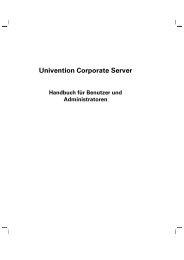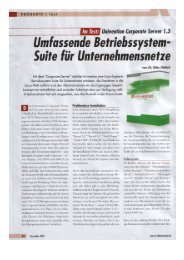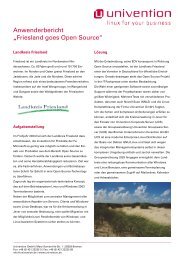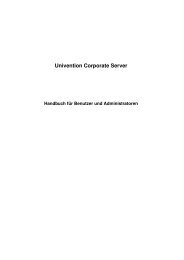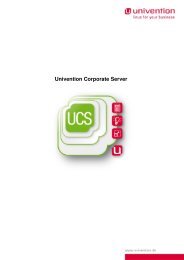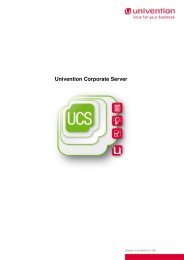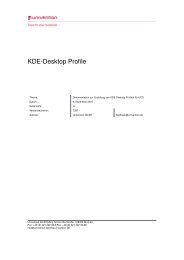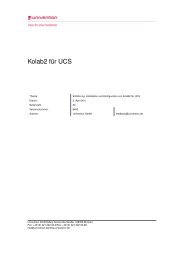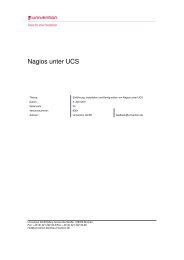UCS 2.4 - Univention
UCS 2.4 - Univention
UCS 2.4 - Univention
Create successful ePaper yourself
Turn your PDF publications into a flip-book with our unique Google optimized e-Paper software.
11 Software maintenance<br />
The package lists themselves do not prompt the installation or removal or packages. Package lists are<br />
used much more often in package policies relating to specific system roles, which allow the installation or<br />
removal of packages.<br />
Specific package policies are available for the different system roles (see table). This makes it possible to<br />
link the policies with the domain base and apply a single policy to all computers with the same system role<br />
in the domain without any consequences for computers with other system roles. For example, a package<br />
selection in the package policy for managed clients only applies to computer with the managed client<br />
system role. The policies can also be edited on the appropriate tab of the respective computer objects.<br />
Package policy <strong>UCS</strong> system role<br />
Packages Master DC Master and DC Backup<br />
Packages Slave DC Slave<br />
Packages Member Member server<br />
Packages Client Managed client<br />
Packages Mobile client Mobile client<br />
The following steps must be performed when using package lists.<br />
New packages list are created under Navigation ➞ univention ➞ packages in <strong>Univention</strong> Directory<br />
Manager.<br />
Notes on the creation of package list objects can be found in Chapters 4.4 und 4.5.11.<br />
The entry Settings: Package list is selected from the Add new object at current position menu and a<br />
Name for the package list entered in the appropriate text field.<br />
The name of the desired package is entered in the Package List input field. For example, if the Emacs<br />
editor should be installed on all managed clients. The name of the package is entered without the version<br />
number and the ending .deb, which gives emacs. The package is entered with the [Add] button. Further<br />
package names can be entered as required.<br />
The package list is saved by clicking on [Ok]. The package lists created can be used in a package policy<br />
specific to a system role. A policy is then created directly on a computer object.<br />
A computer object is opened on which the packages from the package list should be installed, e.g., on a<br />
managed client. The [Packages] tab is opened (see Figure 11.2). There are two areas in which package<br />
lists can be selected. Packages which should be installed can be given in the upper area and packages<br />
which should be deleted can be given in the lower area. The previously created package list is selected<br />
from the Package list menu. The package names contained in the package list can not be selected after<br />
each other under Package Installation list and added to the list of packages to be installed using the Add<br />
button.<br />
The settings are saved by clicking on [Ok].<br />
A package policy specific to system roles created in this way can also be reused. The path to the policy is<br />
given in the Configuration field on the policy itself. For example, the entry Packages can be selected via<br />
(current) ➞ Policies on a computer object and the previously created policy selected in the Configuration<br />
menu . Once the page has been refreshed, the values are shown in the text field which were entered<br />
originally. These settings apply to all managed clients below the computer container on activation.<br />
244



